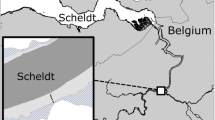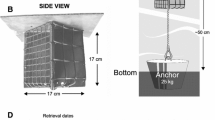Abstract
The extent to which energy is transferred directly from benthic meiofauna to epibenthic predators was investigated on an intertidal sand-flat in the Exe estuary, southwest England, during 1981–1982 and compared with data obtained from an intertidal mud-flat in the Lyhner estuary, also in south-west England, between 1978 and 1981. Two species of flatfish (Pleuronectes platessa L. and Platichthys flesus L.), two species of goby [Pomatoschistus microps (Krøyer) and P. minutus (Pallas)], brown shrimp (Crangon crangon L.) and shore crabs (Carcinus maenas L.) are the most common epibenthic predators feeding on the benthic invertebrates in these locatites. Harpacticoid copepods are the only component of the meiofauna to form a significant part of the diet of early juvenile stages of these predators, particularly the invertebrates. Harpacticoids are a more important source of food for predators feeding over the sand-flat than for those feeding on the mud-flat because in the sand-flat alternative prey of suitable size, such as small annelids, are absent. Moreover, the impact of predation on the mud-flat is spread over the whole harpacticoid species spectrum whereas on the sandflat it is confined almost entirely to a single species, Asellopsis intermedia (T. Scott). Flatfish, gobies and shrimp consume daily an estimated 0.01 to 0.1% of the standing stock of A. intermedia and account for between 12 and 22% of the observed reduction in the population of this species between July and October. Therefore, only a very small proportion of total meiofauna biomass is transferred directly to higher trophic levels.
Similar content being viewed by others
Literature cited
Alheit, J. and W. Scheibel: Benthic harpacticoids as a food source for fish. Mar. Biol. 70, 141–147 (1982)
Bell, S. S. and B. C. Coull: Field evidence that shrimp predation regulates meiofauna. Oecologia (Berl.) 35, 141–148 (1978)
Bregnballe, F.: Plaice and flounder as consumers of the microscopic bottom fauna. Meddr Danm. Fisk.-og Havunders (N.S.) 3, 133–182 (1961)
Castel, J. et P. Lasserre: Regulation biologique du meiobenthos d'un ecosystem lagunaire par un alevinage experimental en soles (Solea vulgaris) Oceanol. Acta SP, 243–252 (1982). (Actes Symposium International sur les lagunes cotieres, SCOR/IABO/UNESCO, Bordeaux, 8–14 Sept. 1981)
Coull, B. C.: The use of long-term biological data to generate testable hypotheses. Estuaries 8, 84–92 (1985)
Coull, B. C. and S. S. Bell: Perspectives of marine meiofauna ecology. In: Ecological processes in coastal and marine systems, pp 189–216. Ed. by R. J. Livingstone. New York: Plenum Publishing Corporation 1979
Crothers, J. H.: The biology of the shore crab Carcinus maenas (L.) 2. The life history of the adult crab. Fld Stud. 2, 579–614 (1968)
Edwards, R. and J. H. Steele: The ecology of 0-group plaice and common dabs at Loch Ewe. 1. Population and food. J. exp. mar. Biol. Ecol. 2, 215–238 (1968)
Evans, S.: Production, predation and food niche segregation in a marine shallow soft-bottom community. Mar. Ecol. Prog. Ser. 10, 147–157 (1983)
Feller, R. J. and V. W. Kaczynski: Size selective predation by juvenile chum salmon (Oncorhynchus keta) on epibenthic prey in Puget Sound. J. Fish. Res. Bd Can. 32, 1419–1429 (1975)
Fonds, M.: Sand gobies in the Dutch Wadden Sea (Pomatoschistus, Gobiidae, Pisces). neth. J. Sea Res. 6, 417–478 (1973)
Gee, J. M. and R. M. Warwick: Preliminary observations on the metabolic and reproductive strategies of harpacticoid copepods from an intertidal sandflat. Hydrobiologia 118, 29–37 (1984)
Gee, J. M., R. M. Warwick, J. T. Davey and C. L. George: Field experiments on the role of epibenthic predators in determining prey densities in an estuarine mudflat. Estuar. cstl Shelf Sci. 21, 429–448 (1985)
Godin, J.-G. J.: Daily patterns of feeding behaviour, daily rations and diets of juvenile pink salmon (Oncorhynchus gorguscha) in two marine bays in British Columbia. Can. J. Fish. aquat. Sciences 38, 10–15 (1981)
Healey, M. C.: Bioenergetics of a sand goby (Gobius minutus) population. J. Fish. Res. Bd Can 29, 187–194 (1972)
Healey, M. C.: Utilization of the Nanaimo river estuary by juvenile chinook salmon, Oncorhynchus tshawytscha. Fish. Bull. U.S. 77, 653–668 (1980)
Heip, C.: The influence of competition and predation on production of meiobenthic copepods. In: Marine benthic dynamics, pp 167–177. Ed. by K. R. Tenore and B. C. Coull. Columbia: University of South Carolina Press, 1980
Hicks, G. R. F.: Spatio-temporal dynamics of a meiobenthic copepod and the impact of predation-disturbance. J. exp. mar. Biol. Ecol. 81, 47–72 (1984)
Hicks, G. R. F.: Biomass and production estimates for an estuarine meiobenthic copepod, with an instantaneous assessment of exploitation by flatfish predators. N.Z. Jl Ecol. 8, 125–127 (1985)
Hicks, G. R. F. and B. C. Coull: The ecology of marine meiobenthic harpacticoid copepods. Oceanogr. mar. biol. A. Rev. 21, 67–175 (1983)
Hofsten, A. v., D. Kahan, R. Katznelson and T. Bar-El: Digestion of free-living nematodes fed to fish. J. Fish Biol. 23, 419–428 (1983)
Jobling, M.: Gastric evacuation in plaice, Pleuronectes platessa L. effects of dietry energy level and food composition. J. Fish Biol. 17, 187–196 (1980a)
Jobling, M.: Gastric evacuation in plaice, Pleuronectes platessa L.: effects of temperature and fish size. J. Fish Biol. 17, 547–551 (1980b)
Jobling, M. and P. Spencer-Davies: Gastric evacuation in plaice, Pleuronectes platessa L.: effects of temperature and meal size. J. Fish Biol. 14, 539–564 (1979)
Joint, I. R., J. M. Gee and R. M. Warwick: Determination of finescale vertical distribution of microbes and meiofauna in an intertidal sediment. Mar. Biol. 72, 157–164 (1982)
Klein-Bretler, w. C. M.: Migration of the shore crab Carcinus maenas in the Dutch Wadden Sea. Neth. J. Sea Res. 10, 338–353 (1976a)
Klein-Bretler, W. C. M.: Settlement, growth and production of the shore crab, Carcinus maenas, on tidal flats in the Dutch Wadden Sea. Neth. J. Sea Res. 10, 354–376 (1976b)
Kuipers, B. R.: On the efficiency of a two-metre beam trawl for juvenile plaice (Pleuronectes platessa). Neth. J. Sea Res. 9, 69–85 (1975)
Kuipers, B. R.: On the ecology of juvenile plaice on a tidal flat in the Wadden Sea. Neth. J. Sea Res. 11, 56–91 (1977)
Kuipers, B. R. and R. Dapper: Production of Crangon crangon in the tidal zone of the Dutch Wadden Sea. Neth. J. Sea Res. 15, 33–53 (1981)
Lasker, R., J. B. J. Wells and A. D. McIntyre: Growth, reproduction respiration and carbon utilization of the sand-dwelling harpacticoid copepod, Asellopsis intermedia. J. mar. biol. Ass. U.K. 50, 147–160 (1970)
Lockwood, S. J.: The settlement, distribution and movements of O-group plaice Pleuronectes platessa (L.) in Filey Bay, Yorkshire. J. Fish Biol. 6, 465–476 (1974)
McIntyre, A. D.: Ecology of marine meiobenthos. Biol. Rev. 44, 245–290 (1969)
Pihl, L. and R. Rosenberg: Production, abundance and biomass of mobile epibenthic marine fauna in shallow waters, western Sweden. J. exp. mar. Biol. Ecol. 57, 273–301 (1982)
Pihl, L. and R. Rosenberg: Food selection and consumption of the shrimp Crangon crangon in some shallow marine areas in western Sweden. Mar. Ecol. Prog. Ser. 15, 159–168 (1984)
Poxton, M. G., A. Eleftheriou and A. D. McIntyre: The population dynamics of 0-group flatfish on nursery grounds in the Clyde Sea area. Estuar. cstl Shelf Sci. 14, 265–282 (1982)
Poxton, M. G., A. Eleftheriou and A. D. McIntyre: The food and growth of 0-group flatfish on nursery grounds in the Clyde Sea area. Estuar. cstl Shelf Sci. 17, 319–337 (1983)
Reise, K.: Moderate predation on meiofauna by the macrobenthos of the Wadden Sea. Helgoländer wiss. Meeresunters. 32, 453–465 (1979)
Scherer, B. and K. Reise: Significant predation on micro-and macrobenthos by the crab Carcinus maenas L. in the Wadden Sea. Kieler Meeresforsch. (Sonderh.) 5, 490–500 (1981)
Schmidt-Moser, R. and D. Westphal: Predation of Pomatoschistus microps Krøyer and P. minutus Pallas (Gobiidae, Pisces) on macro-and meiofauna in the brackish fjord Schlei. Kieler Meeresforsch. (Sonderh.) 5, 471–478 (1981)
Sibert, J., T. J. Brown, M. C. Healey and B. A. Kask: Detritusbased food webs: exploitation by juvenile chum salmon (Oncorhynchus keta). Science, N.Y. 196, 649–650 (1977)
Strauss, R. E.: Rellability estimates for Ivlev's electivity index, the forage ration, and a proposed linear index of food selection. Trans. Am. Fish. Soc. 108 344–353 (1979)
Summers, R. W.: Life cycle and population ecology of the flounder Platichthys flesus (L.) in the Ythan estuary, Scotland. J. nat. Hist. 13, 703–723 (1979)
Tito de Morais, L. and J. Y. Bodiou: Predation on meiofauna by juvenile fish in a western Mediterranean flatfish nursery ground. Mar. Biol. 82, 209–215 (1984)
Veer, H. W. van der and M. J. N. Bergman: Development of tidally related behaviour of a newly settled 0-group plaice (Pleuronectes platessa) population in the western Wadden Sea. Mar. Ecol. Prog. Ser. 31, 121–129 (1986)
Vlas, J., de: Annual food intake by plaice and flounder in a tidal flat area in the Dutch Wadden Sea, with special reference to consumption of regenerating parts of macrobenthic prey. Neth. J. Sea Res. 13, 117–153 (1979)
Warwick, R. M.: Species size distributions in marine benthic communities. Oecologia (Berl.) 61, 32–41 (1984)
Warwick, R. M.: Meiofauna: their role in marine detrital systems. In: Detrital systems for aquaculture. ICLARM Symposium volume, Ed. by R. S. V. Pullen and D. J. W. Moriarty. Manila: International Center for Living Aquatic Resources Management 1987. (In press)
Warwick, R. M., I. R. Joint and P. J. Radford: Secondary production of the benthos in an estuarine environment. In: Proceedings of the First European Ecological Symposium: ecological processes in coastal environments, pp 429–450. Ed. by R. L. Jeffries and A. Davy. Oxford: Blackwell Scientific Publications 1979
Author information
Authors and Affiliations
Additional information
Communicated by J. Mauchline, Oban
Rights and permissions
About this article
Cite this article
Gee, J.M. Impact of epibenthic predation on estuarine intertidal harpacticoid copepod populations. Mar. Biol. 96, 497–510 (1987). https://doi.org/10.1007/BF00397967
Accepted:
Issue Date:
DOI: https://doi.org/10.1007/BF00397967




